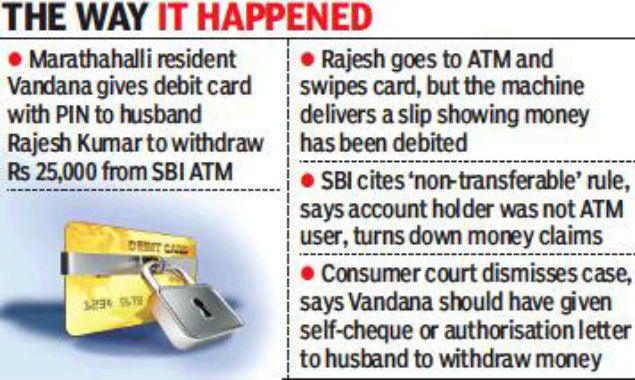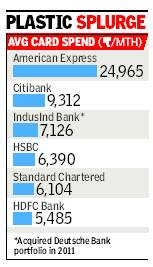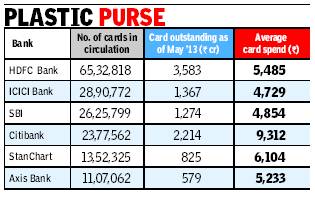Credit/ Debit cards: India

GOODBYE CASH, BUY BUY DEBIT CARDS
In five years between 2011 and 2016, the number of debit cards saw a threefold spiral that shows that more and more people are comfortable using debit cards
The Times of India
This is a collection of articles archived for the excellence of their content. Readers will be able to edit existing articles and post new articles directly |
Contents |
Card usage
2017: Card use rises, complaints dip
Credit card use jumps but plaints dip, December 20, 2017: The Times of India

From: Credit card use jumps but plaints dip, December 20, 2017: The Times of India
Despite a sharp jump in the number of credit cards in use, complaints regarding credit cards have dropped significantly. According to data released by the Reserve Bank of India (RBI), credit card-related complaints dropped over 5% despite a 27% jump in customer complaints in the overall banking sector.
According to the annual report of the banking ombudsman — an institution which adjudicates on consumer complaints — there is a decline in the number of credit card-related complaints as well as their percentage share of these complaints. In FY16, the ombudsman received 8,740 credit card complaints, which accounted for 8.5% of total banking complaints. In FY17, the number dropped to 8,297, or 6.5% of the total sector’s. This was despite the number of credit cards rising from 2.4 crore to 2.9 crore during the same period.
Bankers say that the number of complaints has dropped because of digitisation and measures to promote electronic bill payments. Also, security features have been improved.
However, while credit card complaints have fallen, there is a perceptible rise in the number of ATM /debit cardrelated complaints, which increased by 12.5% during the year under review. Out of a total of 24,731 card-related complaints, 16,434 complaints pertained to ATM/debit cards (12.5% of total complaints received). Card-related complaints (both debit and credit) comprised 18.9% of total complaints and accounted for the second highest number of complaints.
Total complaints stood at 1.30 lakh. Non-dispensation/ short dispensation of cash in ATM withdrawals was the major cause of complaints under this category. Complaints related to credit cards constituted 6.4% of total complaints received during 2016-17.
2008-18: growth in debit card usage

From: Rachel Chitra, India to have 1 billion debit cards soon, from just 84m 10 years ago, November 4, 2018: The Times of India
See graphic:
2008-18: growth in debit card usage
Credit card spend rises
Average credit card spend up 42% in 2 years
Big Driver: 0% EMI On Phones And Durables
Mayur Shetty TNN
The Times of India 2013/07/23
If there is one business that has defied the slowdown, it is credit cards. Average monthly spend per card has jumped 42% (2013) to Rs 6,322 from Rs 4,462 (in 2011). Banks attribute the rise primarily to a payment innovation termed ‘EMI at POS’, which enables manufacturers and retailers to sell smartphones and consumer durables under monthly installment schemes without their taking any credit risk or the buyer bearing any interest cost.
Total spending on credit cards increased 57% to Rs 12,380 crore in May 2013 from Rs 7,880 crore in May 2011. Part of this is due to the card industry returning to growth after four years and the number of credit cards rising to 1.95 crore from 1.76 crore.
Manufacturers target young people through EMI plans
Manufacturers are targeting young people with relatively lower incomes through EMI schemes to expand the market as well as clear inventories, particularly for expensive products such as smartphones. While manufacturers are prepared to get their payments in instalments, they do not have the wherewithal to assess credit worthiness or recover payments. “In the case of EMI at POS, the merchant or the manufacturer bears the interest burden but if the cardholder defaults, the risk is borne by the credit card issuer,” said banker Mohapatra.
Card companies have been offering customers the option to convert some of the large purchases into consumer loans which can be repaid in instalments over some years. But the response has been lukewarm as Indian consumers are interest-averse with almost 80% choosing to repay their entire bill by the month-end instead of rolling over.
“In recent years, several new entities have started accepting card payments. This includes insurance companies and government utilities. But the biggest driver for increase in size of transactions has been the zero-interest EMI option,” said Visa’s country manager Uttam Nayak. Visa has been aggregating hundreds of high value billers across the country, from LIC to electricity, gas, telecom, and water utilities where bills can be viewed and paid online.
Another driver is that banks are getting innovative with their rewards programmes. For instance, the Citibank PremierMiles credit card, which targets air travellers, offers reward points which work as a virtual currency as they can be used for airline tickets, hotels and car rental services. “Providing such an innovative proposition drives card preference among engaged customers, thereby increasing the value of spends. Cardholders can now choose what they want to buy using their reward points – be it a big purchase such as an airline ticket or smaller expenses like fuel, apparel or books. With over 65,000 Instant Redemptions per month, this has become the most popular way for redeeming reward points among Citibank customers” said Muge Yuzuak, Head of Cards and Personal Loans, Citi India.
Card companies are in 2013 in a much better position to extend credit than they were in 2008. First, there has been a dramatic fall in wilful defaults. Secondly, banks have learnt their lessons after 2007 when defaults in personal loans peaked; instead, they now issue cards largely to their own customer base.
Rules
Non-transferable even to spouse
Petlee Peter, June 7, 2018: The Times of India

From: Petlee Peter, June 7, 2018: The Times of India
A casual act of letting your spouse or a close relative/friend withdraw money from an ATM using your debit card could prove costly. This is what a Benglauru woman on maternity leave learnt, albeit the hard way.
Banking rules categorically state that an ATM card is non-transferable and no other person apart from the account holder should use it.
On November 14, 2013, Marathahalli resident Vandana gave her debit card with PIN to her husband, Rajesh Kumar, to withdraw Rs 25,000 from a local SBI ATM. Rajesh went to the ATM and swiped the card; the machine delivered a slip showing the money was debited, but the amount was never released. SBI cited the ‘non-transferable’ rule and said the account holder was not the ATM user and turned down the money claims.
Vandana approached the Bangalore IVth Additional District Consumer Disputes Redressal Forum on October 21, 2014, alleging that SBI had failed to refund the Rs 25,000 she’d lost in the ATM transaction. She said she had just given birth and could not move out of home, hence had to ask her husband to draw the money on her behalf.
When the ATM did not release the money, Rajesh called the SBI call centre only to be informed that it was an ATM fault and the money would be reverted to the account within 24 hours. With no sign of the money after a day, he approached the bank’s Helicopter Division branch at HAL with a formal complaint. But much to the shock of the couple, SBI allegedly closed the case in a few days, stating the transaction was correct and the customer got the money.
After running from pillar to post, the couple obtained CCTV footage that showed Kumar using the machine, but no cash being dispensed. They further lodged a complaint with the bank, following which an investigation committee ruled that Vandana, the cardholder, is not seen in the footage.
Meanwhile, Vandana, through an RTI, obtained a cash verification report of the ATM for November 16, 2013, which showed excess cash of Rs 25,000 in the machine. The report submitted in the court was later countered by the SBI counsel who produced a report showing no excess cash.
Before approaching the consumer forum, the couple made a final plea to the bank ombudsman who simply ruled, ‘PIN shared, case closed.’
The case went on for over three-and-a-half years. Vandana said SBI should refund her money which was lost due to an ATM flaw, but the bank stood its ground, citing the rule that sharing ATM PIN with someone else was a violation. Further, the bank produced documents, including log records, showing the stated ATM transaction was successful and technically correct.
In its verdict on May 29, 2018, the court ruled that Vandana should have given a self-cheque or an authorisation letter to her husband for withdrawal of Rs 25,000, instead sharing the PIN and making him withdraw the money. The court dismissed the case.

